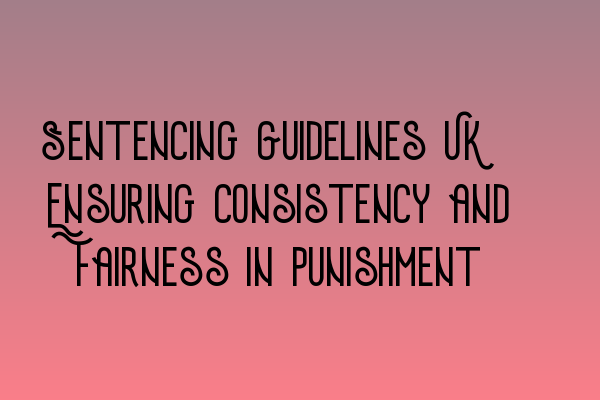Sentencing Guidelines UK: Ensuring Consistency and Fairness in Punishment
When it comes to the criminal justice system, consistency and fairness are of paramount importance. The way offenders are sentenced plays a crucial role in maintaining a just society. To achieve this, the United Kingdom has implemented Sentencing Guidelines that provide a framework for judges and magistrates to follow when determining the appropriate punishment for a conviction.
These Sentencing Guidelines serve several purposes. Firstly, they promote transparency in the decision-making process, helping the public understand the reasoning behind certain punishments. They also ensure consistency in sentencing across different courts and judges, minimizing variations and disparities that can arise from subjective judgments.
It is essential to note that the Sentencing Guidelines are not rigid rules that must be strictly adhered to in every case. They offer a comprehensive framework that takes into account the various factors that could influence the severity of a sentence. Judges and magistrates have the discretion to deviate from the guidelines if they can justify their reasons.
The Sentencing Guidelines cover a wide range of offenses, categorizing them into specific offense types and providing corresponding starting points and ranges for sentences. Offense types include but are not limited to, sexual offenses, drug offenses, violent offenses, and theft offenses. By having these guidelines, the court can ensure that similar crimes receive similar punishment, thereby maintaining consistency and fairness.
Let’s take a closer look at how the Sentencing Guidelines work. When a judge or magistrate is tasked with determining a sentence, they first consider the culpability of the offender. This takes into account the level of intent or recklessness demonstrated during the commission of the offense. The Sentencing Guidelines provide a range of culpability levels, such as high, medium, and low, which can influence the severity of the punishment.
Next, the court examines the harm caused by the offense, considering factors like physical or psychological harm, financial loss, and the impact on the victim. The guidelines provide a range of harm levels, allowing the court to assess the appropriate punishment based on the severity of the harm caused.
Furthermore, the Sentencing Guidelines also consider any aggravating and mitigating factors surrounding the offense. Aggravating factors are circumstances that increase the seriousness of the offense, such as premeditation or targeting vulnerable individuals. On the other hand, mitigating factors are circumstances that reduce the offender’s culpability, such as cooperation with authorities, lack of a previous criminal record, or genuine remorse.
By evaluating these factors, the court can determine a starting point for sentencing within the range provided by the guidelines. The judge or magistrate then considers any additional factors that may adjust the final sentence, such as guilty pleas, previous convictions, or any relevant statutory provisions.
The Sentencing Guidelines aim to strike a balance between punishment, deterrence, rehabilitation, and protection of the public. They provide guidance on the appropriate sentence lengths and the different types of sentences available, including custodial sentences, community sentences, fines, and discharge orders.
It is worth noting that the Sentencing Guidelines are regularly reviewed and updated to ensure their continued relevance and effectiveness. This dynamic approach enables the guidelines to consider changes in legislation, societal attitudes, and emerging trends in criminal behavior.
Implementing Sentencing Guidelines is crucial to the integrity and fairness of the criminal justice system. By providing a clear and consistent framework for sentencing, they help enhance public trust and confidence in the courts’ decisions. Offenders know what to expect if they commit a particular offense, and victims can have faith that justice will be served.
At SQE Criminal Law & Practice Law UK, we understand the importance of staying up-to-date with the latest developments in the legal field. We offer comprehensive SQE 1 preparation courses to help aspiring solicitors gain the knowledge and skills necessary to pass the qualifying exams.
For those already in legal practice, our SQE 2 preparation courses provide targeted and focused training to ensure you are fully equipped to handle the challenges of criminal law and practice.
Stay informed and ahead of the curve with SQE Criminal Law & Practice Law UK. Visit our website to access valuable resources, including SQE 1 practice exam questions and SQE 1 practice mocks FLK1 FLK2.
For information about upcoming SRA SQE exam dates, be sure to check out our article on SRA SQE exam dates. We are here to support you on your journey to becoming a successful solicitor.
Remember, ensuring consistency and fairness in punishment is key to upholding the principles of justice in the United Kingdom. The Sentencing Guidelines provide the necessary framework for judges and magistrates to deliver appropriate sentences that protect society, rehabilitate offenders, and serve the interests of justice.
